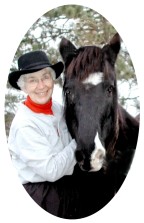A six petaled Dwarf Trout Lily, rather than the usual 4-5 petals, the endangered species that only grows in this area and no where else in the world.
Is there more than what we see?
The chattering rippling sound of a small river as it flows over its rocky bottom... the feel of the soft petals of a flower in your hand... the pungent odor of an herbal leaf... even the taste of wild leeks.
There are five senses used by a human being for physical knowledge. Did you notice that one was left out? That of sight.
Marlys Stevens is blind. She has been since she was 24 years old due to diabetes. Now she is in her 70’s.
For the past several years she has come to see the endangered species of wildflower, the dwarf trout lily. She just likes being in the woodland, she says.
How do you "see"?
She has never “seen” this flower in the normal sense. But she has fine-tuned some of her other senses to help her enjoy what the rest of us view.
Recently another reporter and I decided to focus on Marlys and her “view” of nature.
Marlys explained that since she had previously had several years of sight, her memory helps her visualize what she can’t see.
Memory…
Marlys recalled that “as a kid we took field trips to look at the flowers... Bloodroot, Dutchmen’s Britches, Jack in the Pulpit... and poison oak!” Did I tell you she has a sense of humor?
Marlys continued... I remember all the flowers. And today my memory is much better. Actually I’m using more of my memory now because I can’t see. I just enjoy being out here.
What do you "see"? Rochester Post Bulletin reporter, John Weiss, interviews (l-r) Kay Molstrom and Marlys Stevens to learn what a blind person can "see" in the woodlands.
A friend helps too…
Walking through the woodlands and visualizing the flowers was facilitated by her friend, Kay Molstom, who narrated what she was seeing along the trail.
Kay picked a flower and asked Marlys to smell it.
Then Marlys felt it.
With her guide dog leading her she felt safe, even at one point where we were close to a precipice over the river. Although after the walk her dog enjoyed a little nap at her feet.
Sensory impaired persons can include a variety of limitations. Blindness is just one.
How about you?
But once in a while I will sit by the river and close my eyes to see if I pick up anything I was missing. To focus my concentration.
Basically I just hear the ringing in my ears as it becomes louder! But it’s not bad and soon I start picking up other sounds.
The two tones of the frogs are particularly noisy right now. Or are they crickets? Actually, I don’t have to identify what I’m hearing... just notice it.
I wonder what the responding calls of birds mean to each other.
I smell the odor of the citronella oil I put on my shoes as an attempt to keep woodticks off me. (It’s worth a try!)
Wonderment…
Then I begin to wonder philosophically... are we humans missing any other senses? Maybe because over the generations we didn’t use them... or we forgot them. We hear stories of the ancients or tribes who just "knew" things. Can we tap into that too? Maybe we just need to pay more attention to other "senses".
Marlys Stevens' faithful guide dog takes a moment to relax at her feet after their jaunt along the wooded trail.




